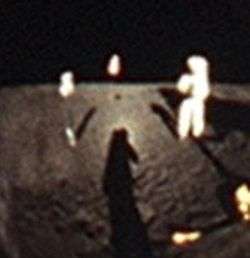Heiligenschein

Heiligenschein (German for "halo" or "aureola", pronounced [ˈhaɪlɪɡənˌʃaɪn]) is an optical phenomenon in which a bright spot appears around the shadow of the viewer's head. In photogrammetry and remote sensing, it is more commonly known as the hotspot.
This diffuse reflection is due to the opposition surge, the reduction in the proportion of shadows viewed at angles close to the backscatter direction. It may also be created when the surface on which the shadow falls has retroreflective optical properties. Both dry regolith and dewy grass are known to exhibit these characteristics. Nearly spherical dew droplets act as lenses to focus the light onto the surface behind them. When this light scatters or reflects off that surface, the same lens re-focuses that light into the direction from which it came. This configuration is sometimes called a cat's eye retroreflector. Any retroreflective surface is brightest around the antisolar point.

The glory is a similar halo effect caused by a different mechanism.
See also
- Aureole effect
- Brocken spectre, the magnified shadow of an observer cast upon the upper surfaces of clouds opposite the Sun
- Gegenschein, a faint spot of dust lit by sunlight focused by Earth's atmosphere, visible in the night sky toward the antisolar point
- Glory (optical phenomenon)
- Opposition surge (also opposition effect or Seeliger effect), the apparent brightening of a coarse surface or aggregate of many particles when illuminated from directly behind the observer
- Retroreflector
- Subparhelic circle
- Sylvanshine
References
- ↑ Hapke, Bruce; Nelson, Robert; Smythe, William (1998). "The Opposition Effect of the Moon: Coherent Backscatter and Shadow Hiding". Icarus. 133: 89–97. Bibcode:1998Icar..133...89H. doi:10.1006/icar.1998.5907.
- ↑ Catalog number AS11-40-5903
External links
| Look up heiligenschein in Wiktionary, the free dictionary. |